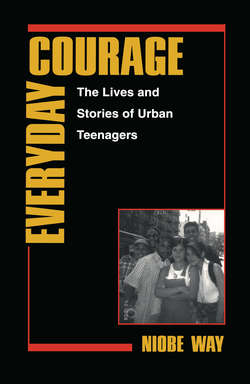Читать книгу Everyday Courage - Niobe Way - Страница 17
На сайте Литреса книга снята с продажи.
The Decentered Experience
ОглавлениеFollowing feminist theory, I resisted framing my project within the unitary truths implied in many developmental theories, and refrained from creating my own unitary and totalizing truths as I listened to and analyzed the interviews. I tried to avoid creating theories that exclude or do not consider the fragmented, contradictory, ambiguous nature of human experience.
Recent feminist writers have emphasized the need to question and even break apart notions such as the unitary self. The “self,” feminist theorists such as Linda Nicholson and Susan Suleiman have argued, is not a unified concept but has many conflicting sides—sides that are at times incommensurable and contradictory. Like the self, one’s experience in the world also has many sides. Jane Flax encourages us to “tolerate and interpret [such] ambivalence and multiplicity. If we do our work well, reality will appear even more unstable, complex and disorderly than it does now.”33 I would add that developmental psychologists would also benefit from embracing a psychology, espoused by many psychoanalysts, that recognizes the multiple and contradictory ways in which the people we study experience their worlds, along with the numerous and conflicting ways we study and listen to people’s experiences.
A problem evident in much of the research on urban adolescents from low-income families is that these adolescents are often portrayed as one-dimensional and static. They are frequently described by researchers as “hopeless,” “present-oriented,” or having low or high self-esteem without any acknowledgment that these adjectives or phrases may only be true for some of these adolescents part of the time. As suggested in my study, an adolescent may be “hopeless” when speaking about the state of the world, but optimistic when speaking about her or his own future; “present oriented” when speaking about an abstract future, but “future oriented” when discussing her or his own life; having low self-esteem when discussing relationships with friends in general, but having high self-esteem when speaking about a best friend.
In the present study, I listened for the shifts and conflicting aspects of the adolescents’ perspectives or worldviews. The “sense of self” among these adolescents was not static but moving in many different directions at once. In my analyses, I aimed to capture some of this movement. I, as a reader, was also going in many different directions and, therefore, I noted in my analyses the various interpretations or experiences I had as I read the adolescents’ interviews.
Although my findings are centered on various themes that I detected in the interviews, none of the themes I discuss are neat and compact. For example, one of the themes concerns the outspoken voices of the girls in the study. What the girls’ interviews also suggest, however, is that these outspoken voices are only evident in certain contexts and relationships. Representing their voices as exclusively outspoken oversimplifies and thus distorts their stories. In my analyses, I note the nuances within each theme so that their stories do not get reduced to a simple set of patterns. Furthermore, there was, at times, a lack of clarity in the narratives (mine and theirs) and, therefore, my discussions often reflect these tensions: Was the theme really there? Was I only seeing it because I wanted to see it? When and why was it not there?
While I argue for heightened awareness of complexity, Susan Bordo warns us, and I concur, that there is always a limit to this “dance” of ambiguity.34 At some point, there are patterns in the ways in which we experience or see our worlds, and these patterns may exist across or within specific class, race, gender, and regional categories. These patterns are not, however, evidence of a unitary self or story, rather they are evidence that experience is always traversed by consistency as well as inconsistency, ambiguity as well as clarity. The focus of my study is on capturing differences as well as commonalities in the ways in which the adolescents speak about their worlds over time.
